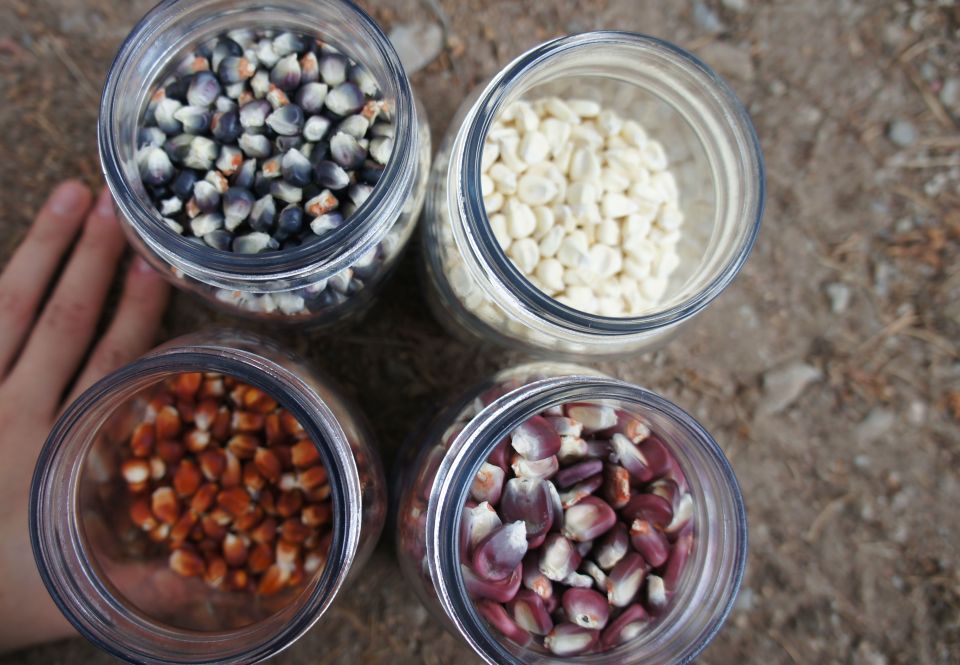
By Emily Arasim, NMAA Farm Apprentice
The practice of saving and passing down seeds from hand to hand, amongst families and neighbors, has been maintained for countless generations amongst New Mexico’s Indigenous and traditional acequia farming communities.
Over time – economic, social, and other changes at the state and global level have pressured farmers to stop saving their own seeds; and have in many places resulted in fewer exchanges of diversity, knowledge, stories, and skills between elder and younger generations.
However here in New Mexico, roots run deep, and many have quietly held tight to treasured varieties and know-how.
As we look towards a year of stress on our watersheds and acequia systems, it could not be more clear why we need to continue to protect, save, and share local, traditional seeds. Traditional seeds – such as our many place-based types of maíz, habas, beans, sunflowers, and chiles – remember, and grow stronger and more resilient with every year of good care, as they adapt to specific local soils, waters and unpredictable weather conditions.
Saving our own seeds can also reduce yearly farm costs, and bring us the best health and happiness, as we select and save what tastes and works best for our families, businesses and diverse cultural uses.

In case you need a refresher as we prepare for planting – in case you don’t have abuelos or neighbors to advise you – in case you have never tried your hand at saving seeds before – here are a few tips for the year.
- The best seeds are local seeds from fellow farmers and seed exchanges (such as Owingeh Ta in April!). If you need to buy from companies to get started – open pollinated and organic are important terms to look for, and you can also search for traditional NM varieties in several catalogues.
- To maintain the strength of a seed, it is important to grow out at least a small group of the same variety (not just one plant!), and at the end of the year, mix together the seeds from as many individuals as possible. This ensures good diversity for re-planting next year.
- If you are growing multiple varieties of the same crop (such as two different types of squash), and you don’t want them to cross-pollinate – try keeping space between varieties, planting varieties so they flower at different times, and/or planting hedgerows, such as sunflowers, in between varieties.
- Seeds like to mature on the plant and/or in their pods or fruits for as long as possible, before being harvested and laid to dry in an area with shade and good air-flow. Traditional corn braids and chile ristras are both beautiful and functional ways to dry and save seeds long-term.
- After drying, it is important to clean out excess soil and leaf matter, which can cause mold when seeds are stored. Using screens or kitchen strainers will do the trick, or try the wind or a small fan to blow away debris.
- Glass jars are ideal storage containers for keeping moisture and pests out! Cloth sacks, paper bags, envelopes, baskets, clay vessels and metal cans also work – just try to avoid plastic.
- Seeds are happy stored in a cool, dry place – and can last for many years (or even decades or hundreds of years) under optimal conditions. Lucky for New Mexicans, most adobe homes are naturally perfect!
- Remember to label your seeds with as much information as possible – What is it called? What year was it last grown and where? What were the growing conditions, and what was learned about this variety? Who gave you the original seed? What is the origin story or history of the seed? What is its history within your family or community? What are favorite ways to enjoy eating or making medicine with it?
- If you have old seeds and are not sure if they’re still good for planting – a germination test can help check before spending time and energy in the field. Simply fold a paper towel in half a few times; lay out a row of seeds on the towel and fold them in; label the outside (seed name, date, total number of seeds); thoroughly wet with a spray bottle; put in a plastic baggie; seal it closed; and place in a warm place. After a week or so, carefully open up the towel and check out your (hopefully!) sprouted seeds. You can count the number of sprouts, and divide this by the total number of seeds to find your germination rate (15 sprouted / 20 seeds = 75% germination).
- At the end of the season, share your seeds and stories! If you can, pass these precious gifts on to the next generation of young farmers.
The deepest thanks go to the mentors who have shared seeds, teachings, and encouragement with me; to every farmer and family across the state saving their heritage; and to the New Mexico Food and Seed Sovereignty Alliance (of which NMAA is a part), which works to protect our right to continue these vital practices.
I hope these tips will encourage you to reclaim your relationship with the seeds which sustain us.


Leave a Reply